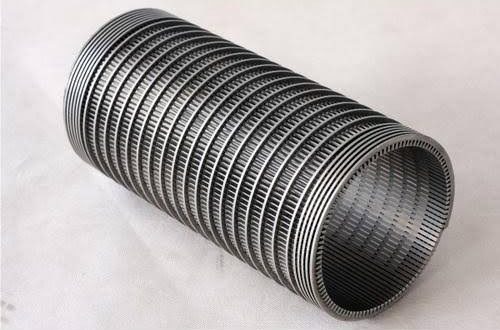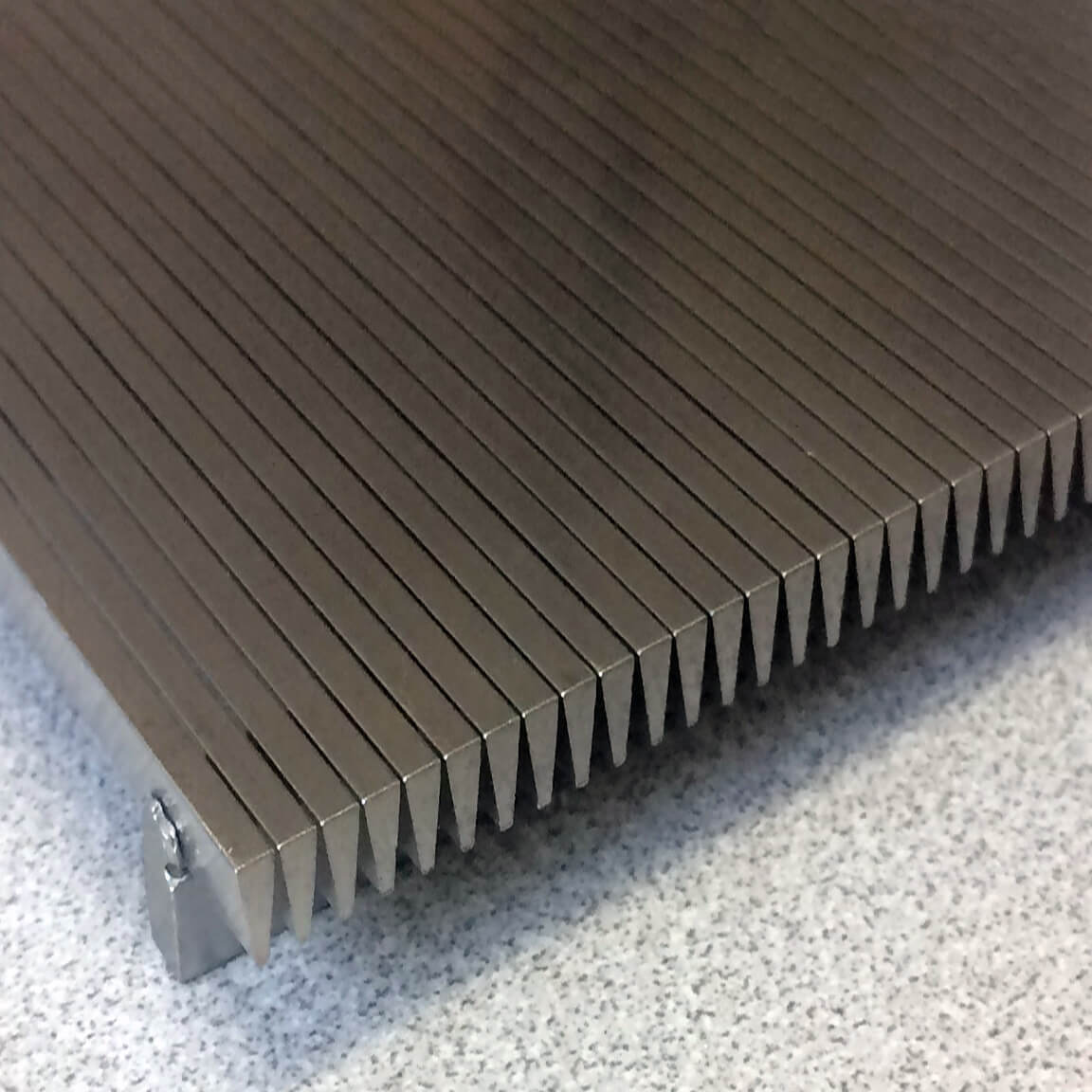Wedge Wire: The Ultimate Guide
Wedge wire, or as it’s sometimes referred to, profile bar, is primarily used in the manufacture of screens. It is categorized as a type of screen wire because it belongs to a family of shapes that are used to manufacture screens, which are used in a wide variety of applications. The product has a triangular shape that varies in height, width and radius on both the nose and corners. Alloys, temper and surface requirements differ based on the what application the screen will be used in. There will be deeper explanation on this later.

Screens themselves are used in a wide variety of industries. Some common end uses are water filtration, mineral processing, pulp and paper manufacturing, food processing, oil extraction as well as in architectural applications. Screen forms may vary as well, coming in flats, cylinders and basket forms depending on functionality of the end use.
For someone just looking at a wedge wire, they might assume the product itself is very simple and straight forward. This couldn’t be further from the truth. Very careful consideration must be taken when developing a specification for wedge wire. End users need to think carefully when making the appropriate selections in order to develop the appropriate screen. The screens then rest on a support which can be provided in round wire, screen wire, or roll formed strip, among other options. This forms a type of screen panel; think of a more complex strainer like one used at home for making pasta.
What materials and alloys are used for wedge wire?
Wedge Wire is very effective for filtering and separating solid materials from fluids. This can be important in multiple settings but depending on the specific application, the alloy and materials needed can vary. Filtering fluid for an application in the food and beverage market, such as a microbrewery beer tank may require a different type of alloy than something in the oil and gas market, like a well screen. Alloy selection may also depend on your manufacturing process and what else needs to be added to the wire before it is ready for use. In some cases, welded wedge wire is needed, while in others the profile provided just needs to be put on the support rod. Alloy selection is critical to the success of the end product. Is the screen being used in a caustic or high temperature environment? Is weight a concern? Is there a need for a softer alloy that is more formable or is the desire for something that is capable of high mechanical properties? As a result, screens are made out of many different alloys depending on the end use. You’ll find wedge wires manufactured out of carbon steel, red metals, aluminum, stainless steels, duplex grades and a variety of other high-performance alloys including Inconel.

There are many options for alloys. These include:
- 300 Series Stainless Steel
- 400 Series Stainless Steel
- 2205 Duplex Stainless Steel
- Carbon Steel
- Titanium
- Aluminum
- Nitronic
- Nickel alloys including Hastelloy, Inconel and Monel 400
Stainless steel wedge wire is often a popular selection given the vast variety of grades and, of course, price considerations. After alloy selection, determining the appropriate size for your application is the next step in the process. Ulbrich can offer this material from roughly .032 inches thick to almost any wire thickness above that. Wedge wire can also be offered in any temper from annealed to full hard. Choosing thickness and temper will also depend on application. The end use of this unique wire shape can vary and because of the different industries that may require filtration can be very useful.
Where and how is wedge wire used?
After the wedge wire itself is produced, it will have to rest on a support, which, as we mentioned earlier, can include round or screen wire, or even strip/sheet. Screen wire and wedge wire screen is often produced in two, sometimes three, types of screens: Flat screen and Cylindrical screen are the main types but within cylindrical, there can be round and basket screens. Flat screen consists of screen wire cut to specific lengths and is welded or dry fit to the screen’s structure. On the other hand, cylindrical screen contains a spool of screen wire paid off onto a machine that winds the wire into a cylinder and welds the wire to the supports as the screen rotates and grows. Flat screens can also be roll formed into cylindrical screens and cylindrical screens can but cut and rolled flat into a flat screen configuration if necessary. These scenarios will depend on the application.

Specific Applications include:
- Food Processing
- Pulp and Paper Manufacturing
- Water Reservoir Intakes
- Oil and Gas - Well Screens
- Mineral Processing
- Microbrewery Beer Tanks
- Architectural Applications
Wedge wire could be used for all of the above as well as more applications across different industries. Wherever filtration may be needed, wedge wire should be considered because of both its’ effectiveness and the fact that it can be provided as a final product. The selection in alloy and thickness will obviously depend on what market and segment the screen is used in. A metallurgist or technical expert could help further if there are any specific questions on this.
Physical Factors with Wedge Wire
It is essential to consider physical factors like surface finish, uniformity and consistency within a wire when considering wedge wire for your application. Continuity of finish is an important factor for screens, particularly with architectural applications. In general, scratches and other visual defects will stand out in most screens quite easily. With architectural products the amount reflectivity can have a big impact and so can the consistency within the surface of the wedge wire. Visually, looking from panel to panel that can have an effect if one run doesn’t look identical to the other.
When it comes to the wire itself, consistency within a spool of wedge wire is critical for making a successful screen. If the wedge wire manufacturer doesn’t have the proper equipment or procedures in place for verifying uniformity within a spool the screen wire manufacturer runs several risks. Variations in the spool means variations within the slots of that screen. The best-case scenario is a potential rework of a screen, but then there’s also the worst case scenario, where the entire screens ends up as scrap. Then all of the labor and time that went into the manufacturer of that screen is lost. Add to that a potential missed deadline to a customer.
Meeting Specifications and Testing
Although many wedge wires have tight tolerances, that doesn’t mean that all wedge wire customers have the ability to verify their final shape in order to confirm that it meets both mechanical properties and corner/nose measurements. Some screen manufacturers do have vision systems to verify the screen slot widths between wedge wires and may be able to look at cross sections of the wedge. Many can only trust that the producer of the wedge wire is meeting the specification. That is why it’s critical for screen manufactures to align themselves with a vendor who adheres strictly to the requirements laid out by them and the screen designers.

It’s not an unheard-of occurrence to run into the situation where Ulbrich has reviewed a customer print and we’ve had to request revisions only to have the customer come back to us saying, “My current supplier makes it to print.” As a follow up we always request a sample to verify the measurements and in the vast, vast majority of cases the wedge wire isn’t to print, and the customer has never been aware of that fact.
Just like with many other industries, screen wire specifications continually get tighter and tighter. As a result, it’s critical to select a wedge wire vendor who not only invests in the latest technology to manufacture that wire but also invests in the appropriate testing equipment and vision systems to guarantee you’re getting what you’re ordering.
Having a long term understanding of all the factors that go into making a successful wedge wire/profile bar is an important factor too. Due to Ulbrich being so diverse in the products we manufacture, our quality systems from other industries flow through our entire business. The same care and quality standards that have gone into successfully manufacturing our aerospace and medical applications for decades also apply to our wedge wire as well as all other products that we produce.
Ulbrich Wedge Wire
This material can be offered at Ulbrich to your exact specifications. Through our annealing, wire drawing, flat wire rolling, wire shaping processes, the final product can be sent to the customer in a final shape that meets the print exactly. Important factors to consider include controlling the radius of both the nose of the shape and the corner. These are instrumental control points in the manufacturing process because they will determine how well the screen can filter out unwanted material and directly impact flow rates (how fast fluids pass through the screen). Slot width and corner radiuses are very dependent on application and are essential dimensions to consider when deciding on your wire because this will determine the size of materials allowed through the filter. Ulbrich’s industry leading tight tolerances and metallurgical support can help with deciding on what dimensions to go with and other factors that need to be considered such as fluctuations in hardness, inconsistent finish, or other quality issues. Please contact us today to learn more.


